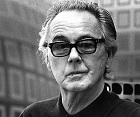Vasarely Victor
1906 - 1997

Vasarely, Victor
Victor Vasarely was a painter and graphic designer. He was born as Győző Vásárhelyi and changed his name to Victor Vasarely after his emigration.
He started his studies at Sándor Bortnyik’s famous private school, Műhely, which was a Hungarian version of the German Bauhaus. Vasarely studied at Műhely for two years, and he exhibited his works at the exhibitions in which the school participated. They usually exhibited poster designs, and some printed works as well.
Magazines, like Kerék (Wheel – which was a magazine for car enthusiasts) and Magyar Magazin (Hungarian Magazine) sometimes offered Vasarely the possibility to design covers or illustrations. These works showed Vasarely’s somehow delicate modernist style. Other designs by him from the late 1930s show a very modern, constructivist style, close to Bortnyik’s. His design for the tobacco brand Modiano shows his special transitional style between clear modernism and the elegant Art Deco. The same splendid and elegant modern world appeared on his poster for the Fasor Sport Fields. He designed posters, book covers and other types of advertising in the early years of his career.
Vasarely emigrated to Paris in 1930, where he initially worked in advertising. After 1960 he became world famous as the inventor of the Op Art style. He created Op Art paintings and optical experiments already back in the 1930s. His famous painting from 1938, the Zebras was made up entirely of curvilinear black and white stripes without any contour lines. This style is defined by optical illusions, eye-catching tricks and black and white or strongly coloured geometric shapes. .
